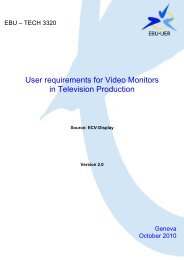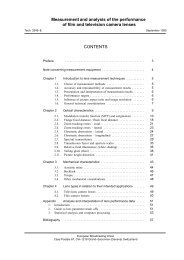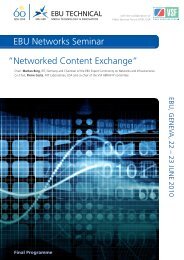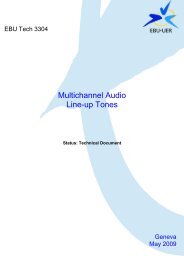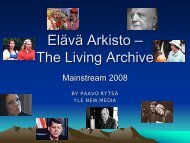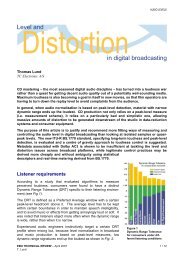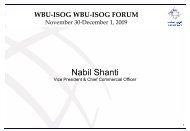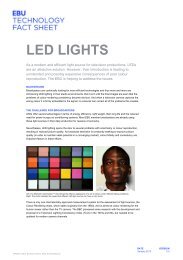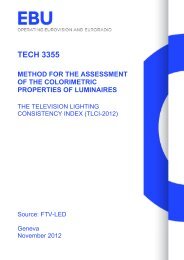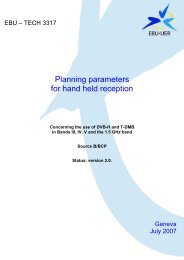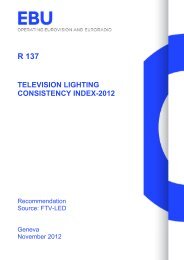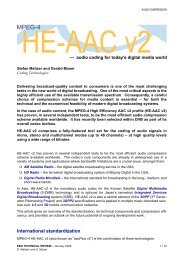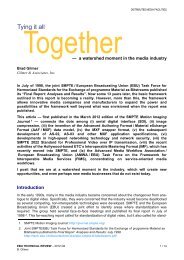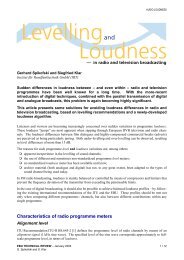Production Technology Seminar 2009 - EBU Technical
Production Technology Seminar 2009 - EBU Technical
Production Technology Seminar 2009 - EBU Technical
Create successful ePaper yourself
Turn your PDF publications into a flip-book with our unique Google optimized e-Paper software.
41<br />
If we have two partners wanting to exchange data [26], they select one common industry XML-based<br />
standard, the <strong>EBU</strong> Core for example [27], they agree upon common terms through a data dictionary [28],<br />
in order to be able to read and understand the data exchanged [29].<br />
In NRK we have used this system for 7 years now. Because of its extensibility, we do not use it only for<br />
programme data but also for programme guides and archive reports, internal and external - for any kind<br />
of programme related metadata, music, news – for traffic situation information – for sports events and<br />
results information – for news and other content for new media. All are defined by this scheme<br />
As we worked with this standard, AES needed an XML standard with descriptive metadata for audio<br />
programmes. AES discussed during the 124th and the 125th AES Conventions its X098A proposal with<br />
the <strong>EBU</strong>, and the 2 partners saw quite early that it could be modelled as a subset of the <strong>EBU</strong> Core<br />
Tech 3293-2008 [31] [32]. The two share the same origin; a similar structure and have a similar purpose.<br />
A formal documentation defining the subset is work in progress. You add the dictionaries you need, in<br />
this case the 'roles' (role list or the different Publisher types) and also 'format' (of the duration field)<br />
definitions [33].<br />
2.12 Video Active – Providing Access to TV Heritage<br />
Johan Oomen, R&D Deparment Manager, Netherlands Institute for Sound and Vision & Siem Vaessen,<br />
Noterik B.V., Netherlands<br />
Video Active is a 36-month European project of the eContentplus programme, which started in<br />
September 2006. Its primary aim was to provide on-line access to a well balanced collection (10.000<br />
video items by <strong>2009</strong>) of Audiovisual heritage coming from AV archives, providing also contextual data<br />
(i.e. stills, programme guides, articles written by academics). The Web site 32 is accessible in 10<br />
languages, not only providing different language schemes but also a multilingual thesaurus. 14 members<br />
from 10 countries and 11 content providers in 10 languages are involved [3].<br />
There are a lot of collections, very heterogeneous (e.g. TV Catalonia is just 15 years established, BBC<br />
on the other hand with a very long tradition). How do we select 10 000 items to represent the European<br />
Broadcast community? Our academics partners came up with a content selection policy based on the<br />
History of Television in Europe, and the European History on Television, exploring and showing the<br />
cultural and historical differences and similarities.<br />
Let's have a look on the project results by watching two clips:<br />
� Video Active clip 33<br />
� BBC 08/11:1987 'Money programme' on 'digital phones' at the Telecom 87 exhibition in Geneva 34<br />
As you can see this is presented in a Flash environment. At the very beginning we had a lot of<br />
discussions with the content providers that we needed to have one single format for playout. At the birth<br />
of the Web TV we had RealMedia (not really an option now), and Windows Media, which is an option,<br />
and is included in this project by some of our partners. But the majority of content is streamed using<br />
Flash with H.263 codec (old Flash) and now the H.264 codec. From <strong>2009</strong> onwards we need to offer<br />
some highest quality footage.<br />
In the portal there are 5 different 'European television History' access pathways: <strong>Technology</strong> –<br />
Institutions – Events – Watching.<br />
The European History is accessed through 34 topics. For example 'Terrorism' brings 40 items divided in<br />
different sets of Genres (e.g; news/documentary) / Languages / Owner / Colour/ Type (A/V) /<br />
Transmission period, allowing the user to filter this offer.<br />
The Video Active architecture [6] comprises various modules, all using Web technologies. It has not a<br />
single streaming playout platform. This is due to IPR restrictions from many of the broadcasters AV<br />
32 www.videoactive.eu<br />
33 On top of the portal: 'Video Active' � then click on the 'videoactive.eu' key frame picture<br />
34 Use the 'Advanched Search' to access it<br />
© <strong>EBU</strong> <strong>2009</strong> / <strong>Production</strong> <strong>Technology</strong> seminar / January 27 - 29, <strong>2009</strong><br />
Reproduction prohibited without written permission of <strong>EBU</strong> TECHNICAL & <strong>EBU</strong> TRAINING



